When contemplating Northanger Abbey, one almost instantly thinks “gothic,” inspired by Catherine’s enthusiasm for “ancient edifices” (143), for “the heaviest stonework, for painted glass, dirt and cobwebs” (166), for the past. This essay, however, argues that Northanger Abbey is not a novel centrally about the gothic. It is a novel concerned with temporal change, both personal and cultural: it captures people and culture on the move. Compared to her other novels, Northanger Abbey is more aware of time, of how the past transitions to the present. Unfortunately, filmed Austen adaptations operate in a more generalized time frame, which cannot capture this aspect of the novel. Instead, they focus on the gothic elements.
A novel about cultural change
Part of Austen’s view of cultural shifting in this book is a distinctly writerly one. She drafted the novel at a time when the reputation of novels was changing. We all know the much-quoted passage where the narrator, while describing Isabella and Catherine reading novels, launches on a defense of the genre:
“Oh! it is only a novel!” replies the young lady; while she lays down her book with affected indifference, or momentary shame. . . . Now, had the same young lady been engaged with a volume of the Spectator, instead of such a work, how proudly would she have produced the book, and told its name; though the chances must be against her being occupied by any part of that voluminous publication, of which either the matter or manner would not disgust a young person of taste: the substance of its papers so often consisting in the statement of improbable circumstances, unnatural characters, and topics of conversation, which no longer concern any one living; and their language, too, frequently so coarse as to give no very favourable idea of the age that could endure it. (31)
Academics who study the Spectator today regard Addison’s and Steele’s writing in the early 1700s as a model of elevated elegance and politeness aimed both a male and a female audience, nor does the antiquated language seem “coarse” at a distance of two centuries. But different eras have different cultures, and Austen is sensitive to changes we can no longer see. As this passage indicates, Austen favors the modern. The romances and novels mentioned in her book—The Mysteries of Udolpho, The Monk, Camilla, and Belinda—were published between 1794 and 1801, the years just before or just when Austen was writing Susan, the novel that would be published after her death as Northanger Abbey. Her defense of these very new books, therefore, would have been cutting edge.
In fact, Austen uses the words new and modern more often in this book than in any other. Voyant Tools visualizes the relative frequency of usage of the words modern and new in Austen’s longer works. In Northanger Abbey, the two words appear far more often relative to other words than in any of the other works. For Jane Austen, Northanger Abbey was therefore very much a book about newness and modernity, as her vocabulary reveals.
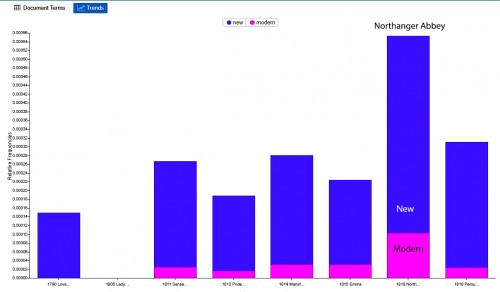
Relative usage of the words modern and new in Austen’s novels (Voyant Tools)
(Click here to see a larger version.)
This consciousness of modernity is perhaps one reason why, after the initial attempt at publication went nowhere, Austen felt the book had to be put aside. This was the first novel Austen sold—in the spring of 1803 to London publisher Crosby & Co., who also had an office in Bath, where she was currently living. The book was advertised (Axelrad; Keymer 22), but it ended up being the last novel of hers to be published—posthumously—in the closing days of December 1817 (though the title page reads 1818). Anthony Mandal speculates that Benjamin Crosby’s parting ways with his business partner was the reason for the non-appearance of the novel Austen sold to him for £10. Financially vulnerable, Crosby was reluctant to publish novels immediately after the split because they were expensive to produce and did not always repay their investment: production costs averaged about £100 per novel. In 1804, the year in which Austen’s first novel should have been published, Crosby & Co. published one novel; the previous year, in contrast, it had published seven (Mandal 522–23). That is probably the reason why Susan, as the first version was named, never came out: Crosby & Co. had to retrench and play it safe.
Margie Burns offers an additional hypothesis: “Crosby in 1803 deliberately jettisoned Austen’s book for textual reasons,” specifically because of its attack on The Spectator, an edition of which Francis Prévost and Francis Blagdon were currently preparing for Crosby & Co. Apparently, “Crosby developed a publishing relationship with Blagdon in particular that put Blagdon into a position to make editorial decisions” (188), which would explain why Susan would have been among the many novels dropped or delayed.
The publication delay did not go down well with Austen. Six years later, now living in Southampton, Austen sent Crosby & Co. a testy letter on 5 April 1809 that was pseudonymously signed “Mrs Ashton Dennis” (“MAD.— ”). Richard Crosby (son of Benjamin), equally testy, replied three days later that “there was not any time stipulated for its publication” and they were not “bound to publish” the novel (8 April 1809). The author was welcome to get her manuscript back for the same £10 they paid for it. One can assume that, at the time, Austen did not have £10.
On the shelf
Seven years later, in 1816, she did. Having recently published Emma, Austen had some cash in hand and bought back the copyright from Crosby & Co., which was going bankrupt. Scholars disagree as to how much, if anything, was altered after she submitted her manuscript to Crosby & Co.,1 but one change is definite: Austen changed the name of the heroine from Susan to Catherine, probably because an anonymous novel entitled Susan had been published in 1809 (Keymer 22).2
Nevertheless, Austen was not convinced the book was publishable. She wrote to her niece Fanny Knight about the manuscript: “Miss Catherine is put upon the Shelve for the present, and I do not know that she will ever come out” (13 March 1817). Delay had spelled doom: her debutante of a novel was now an old spinster. In fact, as if she knew the work needed an apology, Austen had appended an authorial note to the reclaimed manuscript the previous year: “some observation is necessary upon those parts of the work which thirteen years have made comparatively obsolete. . . . [D]uring that period, places, manners, books, and opinions have undergone considerable changes” (NA 1). She knew the book would face criticism for not being timely: after all, she had been trying to capture a precise moment of cultural transition and apparently felt she had succeeded all too well. It was a novel that aimed to show modernity, a modernity now obviously out of date.
But what in 1816 did Austen see as dated in the novel? Which details to her were “comparatively obsolete”? Austen’s clever interpolation into a work of fiction of a living person, James King, for one. King was Master of Ceremonies at the Lower Assembly Rooms when Susan was accepted by Crosby & Co. in 1803, but he became M.C. for the Upper Rooms in 1805. He died in October 1816, a few months after Austen retrieved her novel from Crosby, rendering his presence in the novel even more anachronistic.
Also problematic were the novels Austen mentioned and defended. Camilla came out in 1796 to considerable acclaim and saw a second edition in 1802. But its author, Frances Burney d’Arblay, who had “married the French emigrant” (43) as John Thorpe notes—as if this were grounds for literary evaluation—moved to France with her husband in that year, and she pretty much disappeared from England’s consciousness. Burney did not return to England for a decade, and the publication in 1814 of her new novel The Wanderer received a lukewarm reception. Camilla was not reprinted until after Austen’s death.
The gothic novel waxed and waned in popularity between 1798, when Austen first started composing her work, and 1817, when she put it on the shelf. Illustrating in a general way its rise and decline is an n-gram broadly tracing the relative popularity of a representative gothic word—Udolpho—in the Google Books database. The graph shows the relative density of the word’s usage relative to other words in each year: a spike indicates either the publication of multiple editions, references to it in reviews or other printed works, or both. The sharp peak in the initial year of publication (1794) reflects the book’s instant popularity: frequent reprintings, multiple reviews, and extensive chatter in magazines. 1796 is the peak for the term. It declines after that, reaching a relative low point in 1803. A sixth edition of Radcliffe’s romance was reprinted in 1806, but the seventh did not come out for another ten years, indicating limited demand. As the n-gram shows, neither the 1806 nor the 1816 editions caused a spike in new interest. In fact, many of these later hits are actually for The Monk of Udolpho, an 1807 novel by Thomas Isaac Horsley Curties, or for the Duke of Hamilton’s racehorse Udolpho. And Udolpho’s lifespan anticipates that of other novels in the genre.
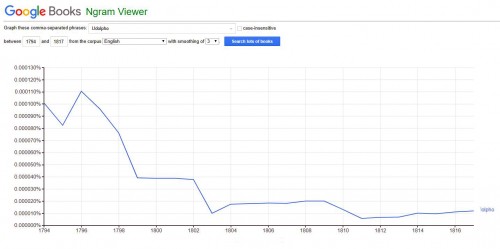
Relative popularity of the word Udolpho from 1794 to 1817 (Google Ngram Viewer)
(Click here to see a larger version.)
Franco Moretti’s method of the “distant reading” of hundreds of British novels demonstrates quantitatively that Gothic novels are the number-one fictional genre being published from 1790 to about 1815, its share of the market peaking in 1805 (Moretti 15). In 1815, the historical novel moves into the top slot, the new fashion given a boost by Sir Walter Scott’s Waverley, published anonymously in 1814 (Moretti 17). Had Austen’s novel been published in 1804, as intended, it would have been satirizing the genre at its peak popularity, even if Mrs. Radcliffe herself were no longer the hottest of properties; by 1816, however, the genre of the gothic novel is a diminished thing.
What’s in, what’s out
Details of consumer culture changed, too. Indian muslins were the fashion at the turn of the century; by 1817, though, they had been displaced, no doubt to General Tilney’s approval, by well-made cotton fabrics woven in the north of England, thanks partly to high tariffs imposed on imported cloth in 1813 (Swamey). As manufacturing had improved in the United Kingdom, there would have been no shame in wearing something not a “‘true Indian muslin’” (NA 20). Indeed, the July 1816 issue of Ackermann’s Repository for the Arts notes that “the productions of our own looms may vie with those of any other country” (“General Observations” 53). The general’s advocacy of British manufacturing is also less innovative after a long war with Napoleon, and six years of trade embargos (1806–1812) made “buying British” a patriotic and practical necessity.
John Thorpe’s curricle-hung gig (41) would have been very much the thing in 1803. A search in the British Newspaper Archive turns up many newspaper advertisements for such gigs, the earliest appearing 1797, with the number for sale really taking off in 1799. A Dublin coach-maker advertising in Saunders’s News-Letter offered “two new gigs, curricle hung, in the present style” (5 December 1799), demonstrating the fashionableness of the vehicle (BNA). The precise parroting of the language of classified advertisements in Thorpe’s dialogue shows what careful attention Austen paid to options available on vehicles of the moment: “‘Curricle-hung, you see; seat, trunk, sword-case, splashing-board, lamps, silver moulding, all you see complete; the iron-work as good as new, or better’” (41). Transport styles dated as much in Austen’s time as in ours, it seems, since the curricle-hung gig vanishes from advertisements after 1810.

Coachmaker’s advertisement, Morning Post (London), 5 November 1800 (BNA)
Even the English language changed. Henry Tilney explicitly comments on the recent change in the meaning of the word nice: “‘this is a very nice day, and we are taking a very nice walk, and you are two very nice young ladies. Oh! it is a very nice word indeed!—it does for every thing’” (109). His sister Eleanor mocks him for being so old-fashioned and persnickety, claiming “‘we shall be overpowered with Johnson and Blair’” (109).3 Austen creates the double-edged satire through a precise attention to how times have changed linguistically. By 1817, the meaning of nice as “Accurate in judgment to minute exactness” (Johnson) was probably even more reactionary, though Austen herself continues to use it almost exclusively in that sense in the narrated sections of her novels. Her characters, however, frequently use the newer sense in their speech.
Northanger Abbey is invested in the documentation of a cultural moment. Brian Southam argues that the novel was originally composed and set in “Bath of the late 1790s, with the correct period features” and some timely updates before submission for publication in 1803 (Jane Austen 19). It was written for a precise time and, as a result, lost its edge when publication was delayed. Recent fashions and trends do not travel well through time. Fortunately, two centuries have blunted the timeliness of her references so they barely register with the modern reader. In the end, time worked in Austen’s favor.
Film adaptations and Austen Time
A future that Jane Austen could not possibly have imagined awaited Northanger Abbey: the filming of her novel. There are two adaptions available from twenty years apart: a 1987 BBC telefilm with a screenplay by Maggie Wadey and a 2007 ITV telefilm with a screenplay by Andrew Davies.4 If the novel is, as we argue, about modernity and culture on the move, how can a film adaptation convey that? The answer is simple: it cannot. Any film audience will be so aware of the split between its present world and Austen’s world, that it becomes difficult to portray on screen. How can one show a modernity that is now two hundred years old?
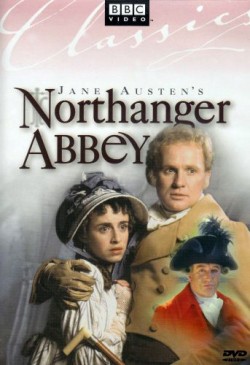 Northanger Abbey. © 1987 BBC |
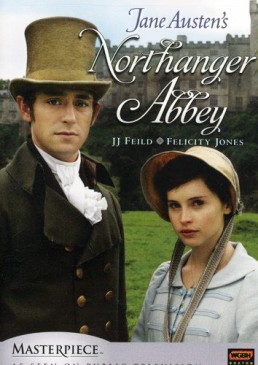 Northanger Abbey. © 2007 ITV |
The films do not even try to do so. Filmed period drama since the mid-1990s has instead worked in something that we have decided to call Austen Time, an amalgamation of period details that viewers instantly recognize as creating the “look” of the time period. It results from the filmic homogenizing of about two decades in the early nineteenth century, and the blending obscures datable cultural trends such as varying hemlines on petticoats and styles of carriages. Sometimes, even greater timespans merge with minimal ill effects. Jennifer Ehle and Colin Firth spar to “Mr. Beveridge’s Maggot,” a dance from around 1700 that no Austen character would have recognized. Keira Knightley shares screen time with Victorian statuary at Pemberley and four well-grown sequoias at Longbourn.5 Soundtracks, dances, food, architecture, and clothing need only strike the audience as “period” or “Regency” to do their work.
After all, film makers are not doing historical re-enactment; they are creating art and entertainment. Nor is historical reconstruction feasible. A screenwriter or director who tries to capture the modernity of the world of Northanger Abbey has to overcome the problem that what is modern to Catherine is really old to the viewer. Also, buildings and towns cannot be made to look as new as they would have to Austen’s characters: they are now historic properties, so the willing suspension of disbelief must come into play. Films operate by different rules, and Austen Time is sufficient for the purpose.
That makes filming Northanger Abbey a challenge. Film is a visual medium, so it ends up focusing less on books and reading, language change, and things that matter a great deal in the novel in order to privilege image. That results in an emphasis upon the gothic, which is eminently visual but largely important only in the second half of Austen’s novel. For example, before Catherine Morland meets Isabella Thorpe in Bath, the only hints of the gothic in Austen’s novel come not in Catherine’s attitude but in narratorial comments about its absence: a lack of robbers, tempests, and bad baronets to beset Catherine on the trip to Bath. The narrator sets a standard for modern social realism in the novel. Admittedly, some critics try to inject the gothic into the first half of the novel, seeing, for example, John Thorpe as a would-be gothic villain, but he is one only in “parody” (NA 326 n12), and his “abduction” of Catherine is ultimately one with ironic quotation marks around it (Yee). Kathy Gentile is amused by “John Thorpe’s bumptious declarations of masculine superiority” (79), but bumptious is the opposite of threatening, and serious threat is the essence of gothic.
More gothic
Both film adaptations, however, bring the gothic in quickly and give it distinctly non-bumptious treatment. Each has Catherine reading the novels of Mrs. Radcliffe before she goes to Bath. The 1987 BBC telefilm shows Catherine lolling in a tree reading what we are to assume is The Mysteries of Udolpho while indulging in erotic fantasies. The 2007 ITV version gives Catherine Mrs. Radcliffe’s The Romance of the Forest to read and fantasize over. By depicting Catherine’s gothic imaginings as a long-standing practice, the films make her later suspicions about General Tilney’s having murdered or imprisoned his wife dramatically consistent. This is not the case in the novel: Catherine tells Isabella that “‘new books do not fall in our way’” (35) at the Morland home. Nor is she especially imaginative until she goes to Northanger Abbey.
The Bath sequences also allow for a filmic interpolation of the gothic. The 1987 film gothicizes the characters with edgy costumes and make-up. John Thorpe is often menacing. Isabella is a little vampiric, and even Henry a bit unnerving, with close-ups that bring him too close for comfort and few hints in his delivery that he is being witty and ironic. Everyone looks surreal, even Catherine at times. The 2007 version initially follows the novel by including a lot of Austen’s wit in the narrative voice-over about Catherine’s childhood, but it quickly moves to the gothic. After her first ball, Catherine dreams that Henry Tilney is rescuing her from a masked villain who turns out to be John Thorpe—even though we know “it must be very improper that a young lady should dream of a gentleman before the gentleman is first known to have dreamt of her” (22). To play up the creepy strain further, Thorpe utters—without a touch of bumptiousness—serious reservations about the Tilney clan. He tells Catherine that “I’m not altogether happy to see you with the Tilneys. The whole family has a terrible reputation. Something very strange about the mother’s death.” We, as well as Catherine, are being primed to think of General Tilney as a gothic villain. In contrast, Austen’s general has a perfectly fine reputation. Isabella tells Catherine, “‘I know no harm of him; I do not suspect him of pride. I believe he is a very gentleman-like man. John thinks very well of him’” (132). The point in both films seems to be that Bath and its visitors are of a piece with a gothic abbey, which does help solve the difficulty of the novel’s seemingly bifurcated tone.
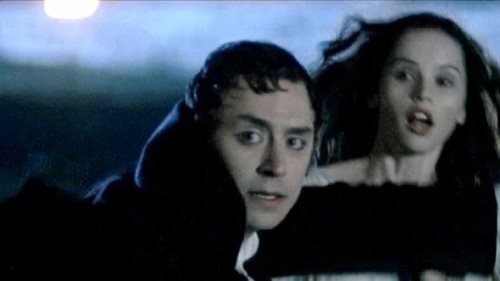
Dream sequence. © 2007 ITV
Austen, however, has actually united the two halves of her novel by showing that getting and spending dominate modern life. Shopping for material goods is central: Bath is full of fashionable clothing, fabrics, and vehicles, and Northanger Abbey is not so different. It is “an anti-Udolpho: bright and clean and hospitable and with every modern comfort and luxury” (Southam, “General” 59). Mr. Tilney knows his muslins; and his father knows his up-to-date consumer goods, much to Catherine’s disappointment:
The [Abbey] furniture was in all the profusion and elegance of modern taste. The fire-place, where she had expected the ample width and ponderous carving of former times, was contracted to a Rumford [invented in 1797], with slabs of plain though handsome marble, and ornaments over it of the prettiest English china. The windows, to which she looked with peculiar dependence, from having heard the General talk of his preserving them in their Gothic form with reverential care, were yet less what her fancy had portrayed. To be sure, the pointed arch was preserved—the form of them was Gothic—they might be even casements—but every pane was so large, so clear, so light! To an imagination which had hoped for the smallest divisions, and the heaviest stone-work, for painted glass, dirt and cobwebs, the difference was very distressing. (165–66)
No film adaptation picks up on the delightful comedy of Catherine’s disappointment with replacement windows, efficient heating, and elegant furniture since it works against the gothic mood the films develop. Neither film shows the house tour, in which the General points out all the mod cons and updates: pro-style kitchen range, modern “offices” for laundry and such, and the latest in gardens and greenhouses for his au courant passion for raising pineapples.6 The gentle mockery of Catherine’s overactive imagination is confined in the films to the funny scene where she finds the laundry lists—though the 1987 film adaptation slips a cryptic letter of romantic assignation into the pile of paper, thereby undercutting Austen’s joke. But modernity does not work with Austen Time. The viewer will have trouble recognizing the extreme newness of a tea set or a fireplace design within the period context. Therefore, even though Austen did the reverse, the films transform non-gothic things in Bath and at the abbey into gothic things.
The depiction of the late Mrs. Tilney’s bedroom is a prime example of this reversal of what the author intended. In the novel, it is located in the new wing, the section built by the General’s father. It is described as a
large, well-proportioned apartment, [with a] handsome dimity bed, arranged as unoccupied with an housemaid’s care, a bright Bath stove, mahogany wardrobes and neatly-painted chairs, on which the warm beams of a western sun gaily poured through two sash windows! Catherine had expected to have her feelings worked, and worked they were. Astonishment and doubt first seized them; and a shortly succeeding ray of common sense added some bitter emotions of shame. (198–99)
The discovery of seeing a clean, cheery, impersonal, and modern room instantly jolts Catherine into realizing that her recently acquired imagination has run away from her. Austen grants Catherine the intelligence to work this out for herself; she does not really need Henry’s lecture. Hearing it, however, is the penance she must undergo for her folly, and it is a good reminder to the readers that they, too, live in a modern world, not a gothic novel.
The films, in contrast, play this scene quite seriously. Both the 1987 and the 2007 films locate the bedroom in the oldest, most remote part of the Abbey, up well-worn stairs, down mysterious passages, through ancient doors. In the 1987 film, the floors and doors creak, the room is full of old oak furniture, Elizabethan portraits and medieval candlesticks. Mrs. Tilney’s personal effects are still present but covered with dust, as if the room had been hastily sealed immediately after her death. The 2007 film adds shroud-like drapes and even more dust. In both versions, there is nothing to give the game away: each antique bedroom could easily have been a room for nefarious activities by a thoroughgoing gothic villain. The films side with Catherine, supporting her fantasy instead of satirizing her, as Austen does. Rather than parody the gothic, they become gothic.
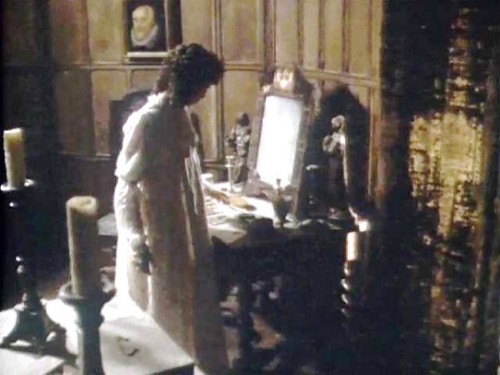
Catherine explores Mrs. Tilney’s bedroom. © 1987 BBC
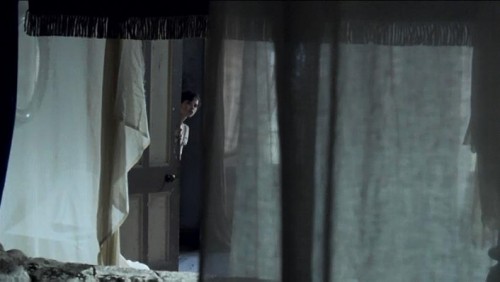
Catherine explores Mrs. Tilney’s bedroom. © 2007 ITV
![]()
For Austen, however, the gothic is not the central issue in her novel. The novel looks squarely at the present. For Austen, what links the scenes at Bath to those at the Abbey is that both show a shallow, modern world full of petty concerns for money, social advancement, and lots of up-to-date possessions: modern novels, showy gigs, fashionable clothing, trendy fruit, modern appliances, and the latest in Staffordshire porcelain tea sets: “this was quite an old set, purchased two years ago” (179), apologizes General Tilney, though actually bragging. Admittedly, the world of Northanger Abbey has its own distresses, but they are modern ones and not in the same league as those in gothic novels. As a result, the films do what Catherine Morland briefly does: make the world more exciting than it is.
Undeniably, Northanger Abbey criticizes those who, in some senses, are too modern—concerned mainly with time and money, like General Tilney—but the satire also falls upon those like Catherine, who romanticize the past. Henry’s rebuke to her when he finds her in his late mother’s bedroom brings the readers jolting back to the present: “‘Remember the country and the age in which we live . . . where roads and newspapers lay every thing open’” (203). Pity the modern viewers, though, who may feel returned from Catherine’s wild imaginings, but will not be returned to their own time, which was the intended effect of Henry Tilney’s “hey, look around you” moment that Austen carefully constructed. After all, they are watching period drama and remain with Catherine in Austen Time, a romanticized past. To date, the film adaptations of Northanger Abbey have proven not entirely satisfactory because they cannot capture the essence of Austen’s novel, which is an appreciation for modern life. Period drama about the modern proves to be a contradiction in terms.
NOTES
1Many editors and critics (see, for example, Wolfson 114) believe Austen’s later revisions to the manuscript of Susan included updating, sometime after 1807, a street name to Union Passage since “the thoroughfare . . . was not so named until 1807” (Keymer 22). Union Street was indeed not completed until 1807, but Austen’s use of the name for the nearby lane or passage mentioned in chapter 7 is not proof of revision. This new name for the former Cock Lane was already in local use by 1797. An auction house in Bath frequently described itself as located in “Union-Passage, late Cock Lane” (Bath Chronicle and Weekly Gazette: 9 March 1797, 8 November 1798, 21 May 1801 [BNA]), indicating a recent name change and distinguishing it from an older Union Passage near the Cross Bath. The lane is also identified by both names in Warner’s 1801 history of Bath (236). Austen surely had this street name in her manuscript from its inception.
2What may be the title page for Austen’s manuscript survives in the Morgan Library, New York (“Susan”).
3Eleanor Tilney means Hugh Blair’s 1783 Lectures on Rhetoric and Dr. Samuel Johnson’s 1755 Dictionary of the English Language.
4Among adaptations, there is also “Pup Fiction,” a 1998 episode of the children’s television series Wishbone featuring a Jack Russell terrier as Henry Tilney.
5Seeds from a giant sequoia tree were first brought from California to England in 1853 (“How”).
6For all its exotic and aristocratic associations, the pineapple was thoroughly enmeshed in the British economy of the day, as George Walker’s novel, The Vagabond (1799) indicates: “How many depend for their share of the guinea paid for the pine apple? The fruiterer, the gardener, the glazier, the carpenter, the brick-layer, the smith, the coal-merchant, the mariner, the miner, with all the crowd of others who supply each of these individuals with materials; and when you shall have divided the guinea between all these, I think the gentleman may eat his pine-apple with a good conscience” (1: 209). A truly timely film adaptation might manage pineapples on the general’s English porcelain tea set, as the fruit appeared “on chinaware designs manufactured by the great businessman Josiah Wedgewood,” and “the motif of the pineapple was one of his most popular products” (Beauman 111).
